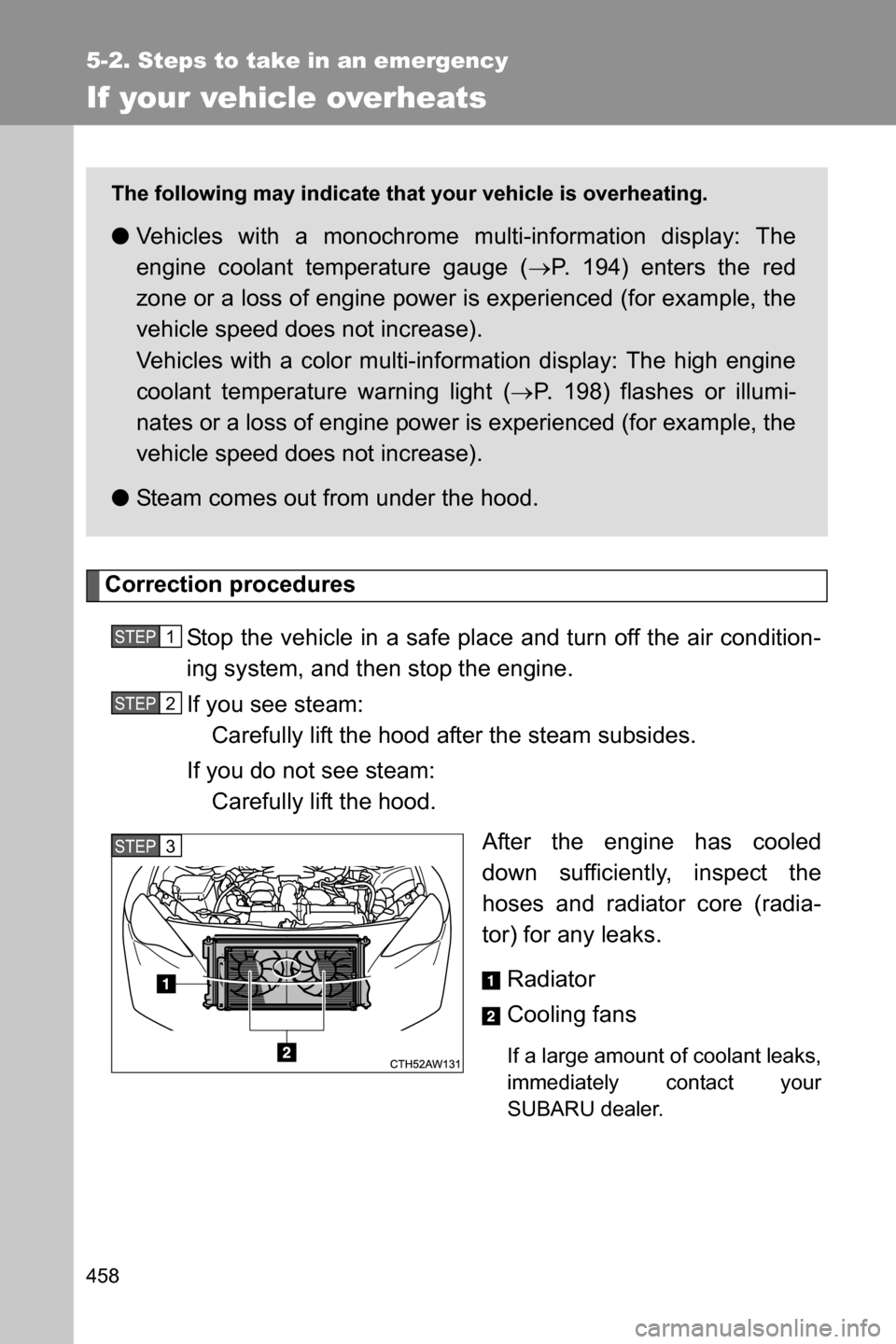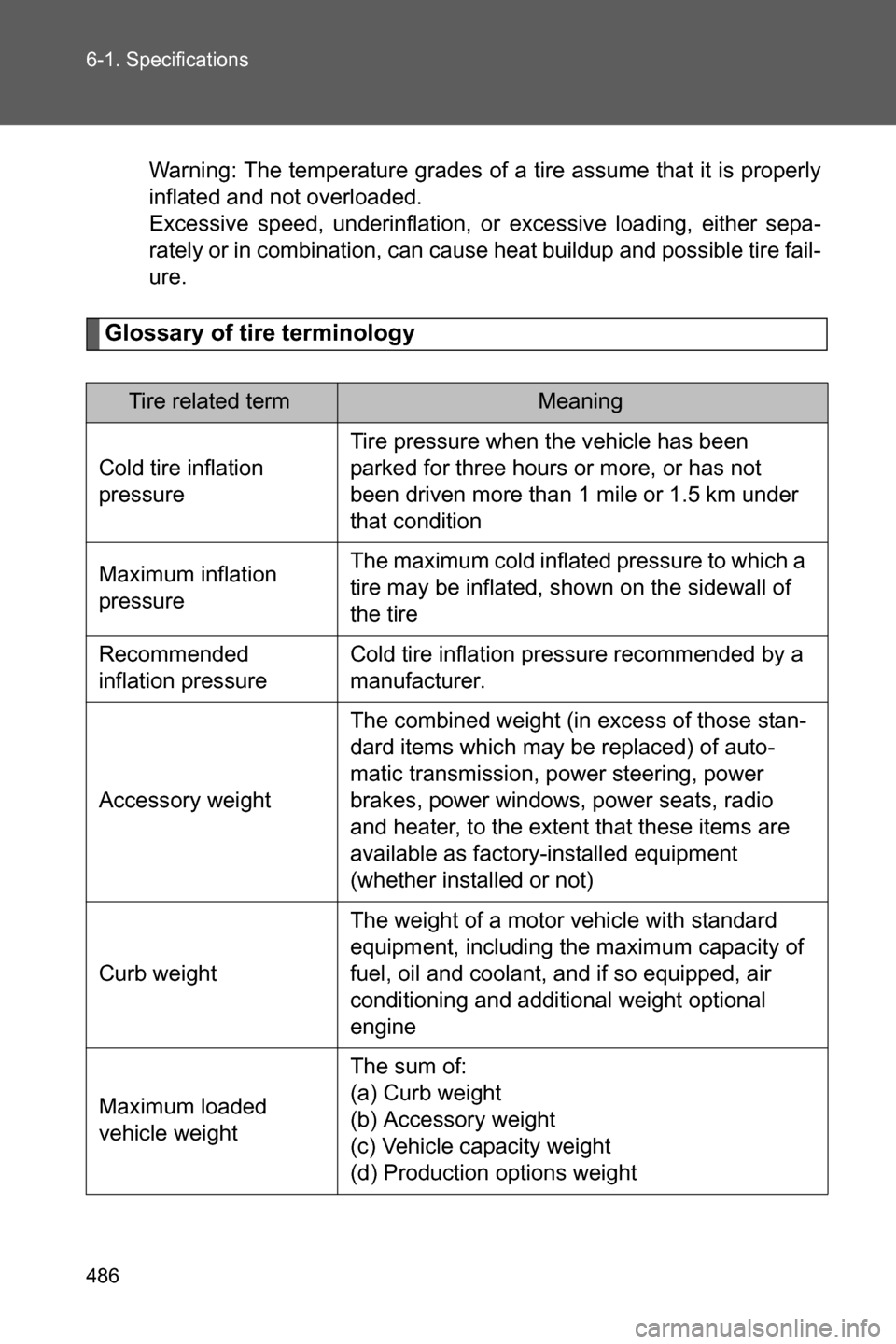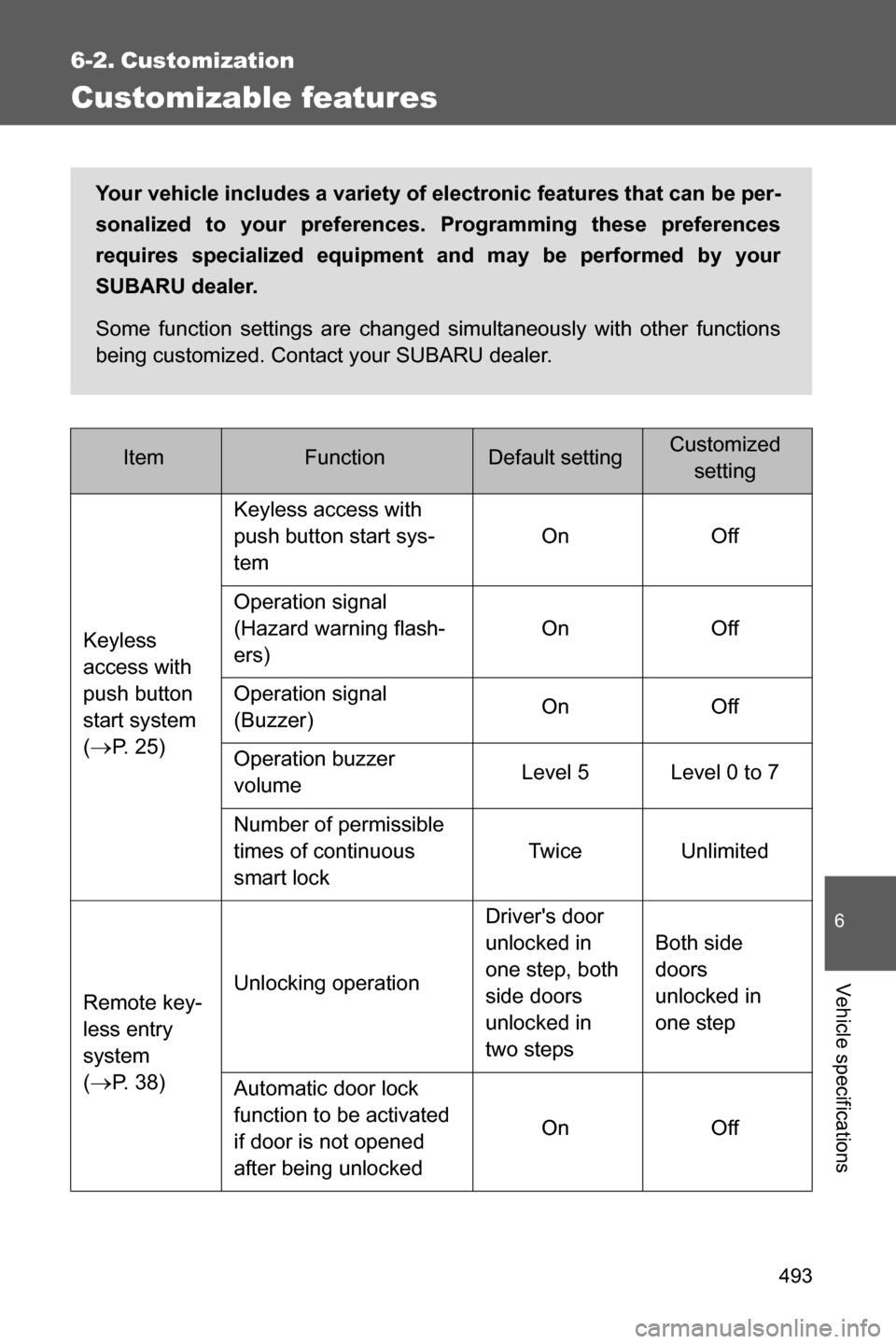Page 460 of 540

458
5-2. Steps to take in an emergency
If your vehicle overheats
Correction procedures
Stop the vehicle in a safe place and turn off the air condition-
ing system, and then stop the engine.
If you see steam:
Carefully lift the hood after the steam subsides.
If you do not see steam:
Carefully lift the hood.
After the engine has cooled
down sufficiently, inspect the
hoses and radiator core (radia-
tor) for any leaks.
Radiator
Cooling fans
If a large amount of coolant leaks,
immediately contact your
SUBARU dealer.
The following may indicate that your vehicle is overheating.
●Vehicles with a monochrome multi-information display: The
engine coolant temperature gauge (�oP. 194) enters the red
zone or a loss of engine power is experienced (for example, the
vehicle speed does not increase).
Vehicles with a color multi-information display: The high engine
coolant temperature warning light (�oP. 198) flashes or illumi-
nates or a loss of engine power is experienced (for example, the
vehicle speed does not increase).
●Steam comes out from under the hood.
STEP 1
STEP 2
STEP 3
Page 462 of 540

460 5-2. Steps to take in an emergency
WARNING
■To prevent an accident or injury when inspecting under the hood of
your vehicle
●If steam is seen coming from under the hood, do not open the hood until
the steam has subsided. The engine compartment may be very hot, caus-
ing serious injuries such as burns.
●Keep hands and clothing (especially a tie, a scarf or a muffler) away from
the fans and belts. Failure to do so may cause the hands or clothing to be
caught, resulting in serious injury.
●Do not loosen the radiator cap and the coolant reservoir cap while the
engine and radiator are hot.
Serious injury, such as burns, may result from hot coolant and steam
released under pressure.
CAUTION
■When adding engine coolant
Wait until the engine has cooled down before adding engine coolant.
When adding coolant, do so slowly. Adding cool coolant to a hot engine too
quickly can cause damage to the engine.
■To prevent damage to the cooling system
Observe the following precautions:
●Avoid contaminating the coolant with foreign matter (such as sand or dust
etc.).
●Do not use any coolant additives.
Page 464 of 540
462 5-2. Steps to take in an emergency
WARNING
■When attempting to free a stuck vehicle
If you choose to push the vehicle back and forth to free it, make sure the sur-
rounding area is clear to avoid striking other vehicles, objects or people. The
vehicle may also lunge forward or lunge back suddenly as it becomes free.
Use extreme caution.
■When shifting the select lever
For vehicles with an automatic transmission, be careful not to shift the select
lever with the accelerator pedal depressed.
This may lead to unexpected rapid acceleration of the vehicle that may
cause an accident resulting in death or serious injury.
CAUTION
■To avoid damage to the transmission and other components
●Avoid spinning the rear wheels and depressing the accelerator pedal more
than necessary.
●If the vehicle remains stuck even after these procedures are performed,
the vehicle may require towing to be freed.
Page 487 of 540

485 6-1. Specifications
6
Vehicle specifications
■Treadwear
The treadwear grade is a comparative rating based on the wear
rate of the tire when tested under controlled conditions on a speci-
fied government test course.
For example, a tire graded 150 would wear one and a half (1 - 1/2)
times as well on the government course as a tire graded 100.
The relative performance of tires depends upon the actual conditions
of their use. Performance may differ significantly from the norm due
to variations in driving habits, service practices and differences in
road characteristics and climate.
■Traction AA, A, B, C
The traction grades, from highest to lowest, are AA, A, B and C,
and they represent the tire’s ability to stop on wet pavement as
measured under controlled conditions on specified government
test surfaces of asphalt and concrete.
A tire marked C may have poor traction performance.
Warning: The traction grade assigned to this tire is based on braking
(straight ahead) traction tests and does not include cornering (turn-
ing) traction.
■Temperature A, B, C
The temperature grades are A (the highest), B, and C, represent-
ing the tire’s resistance to the generation of heat and its ability to
dissipate heat when tested under controlled conditions on a speci-
fied indoor laboratory test wheel.
Sustained high temperature can cause the material of the tire to
degenerate and reduce tire life, and excessive temperature can lead
to sudden tire failure.
Grade C corresponds to a level of performance which all passenger
car tires must meet under the Federal Motor Vehicle Safety Standard
No. 109.
Grades B and A represent higher levels of performance on the labo-
ratory test wheel than the minimum required by law.
Page 488 of 540

486 6-1. Specifications
Warning: The temperature grades of a tire assume that it is properly
inflated and not overloaded.
Excessive speed, underinflation, or excessive loading, either sepa-
rately or in combination, can cause heat buildup and possible tire fail-
ure.
Glossary of tire terminology
Tire related termMeaning
Cold tire inflation
pressureTire pressure when the vehicle has been
parked for three hours or more, or has not
been driven more than 1 mile or 1.5 km under
that condition
Maximum inflation
pressureThe maximum cold inflated pressure to which a
tire may be inflated, shown on the sidewall of
the tire
Recommended
inflation pressureCold tire inflation pressure recommended by a
manufacturer.
Accessory weightThe combined weight (in excess of those stan-
dard items which may be replaced) of auto-
matic transmission, power steering, power
brakes, power windows, power seats, radio
and heater, to the extent that these items are
available as factory-installed equipment
(whether installed or not)
Curb weightThe weight of a motor vehicle with standard
equipment, including the maximum capacity of
fuel, oil and coolant, and if so equipped, air
conditioning and additional weight optional
engine
Maximum loaded
vehicle weightThe sum of:
(a) Curb weight
(b) Accessory weight
(c) Vehicle capacity weight
(d) Production options weight
Page 495 of 540

493
6
Vehicle specifications
6-2. Customization
Customizable features
ItemFunctionDefault settingCustomized
setting
Keyless
access with
push button
start system
(
�oP. 25)Keyless access with
push button start sys-
temOn Off
Operation signal
(Hazard warning flash-
ers) On Off
Operation signal
(Buzzer)On Off
Operation buzzer
volumeLevel 5 Level 0 to 7
Number of permissible
times of continuous
smart lockTwice Unlimited
Remote key-
less entry
system
(
�oP. 38)Unlocking operationDriver's door
unlocked in
one step, both
side doors
unlocked in
two stepsBoth side
doors
unlocked in
one step
Automatic door lock
function to be activated
if door is not opened
after being unlockedOn Off
Your vehicle includes a variety of electronic features that can be per-
sonalized to your preferences. Programming these preferences
requires specialized equipment and may be performed by your
SUBARU dealer.
Some function settings are changed simultaneously with other functions
being customized. Contact your SUBARU dealer.
Page 496 of 540
494 6-2. Customization
Remote key-
less entry
system
(
�oP. 38)Time elapsed before
automatic door lock
function is activated if
door is not opened after
being unlocked60 seconds30 seconds
120 seconds
Operation signal
(Hazard warning flash-
ers) On Off
Operation signal
(Buzzer)On Off
Operation buzzer
volumeLevel 5 Level 0 to 7
Door lock buzzer On Off
Trunk lid unlocking
functionOn Off
Trunk lid unlocking
operationPush and hold
(short)Push and hold
(long)
One short push
Two short
pushes
Panic function On Off
Vehicle finder function On Off
Alarm
(
�oP. 85)
(vehicles
with a key-
less access
with push
button start
system)Operation when doors
are unlocked using the
mechanical keyOff On
ItemFunctionDefault settingCustomized
setting
Page 527 of 540

525
Alphabetical index
Alphabetical index
A/C .................................... 276, 283
ABS........................................... 251
Access key
If the access key does
not operate properly........... 449
Air conditioning filter.............. 364
Air conditioning system
Air conditioning filter ............. 364
Automatic air conditioning
system................................ 283
Manual air conditioning
system................................ 276
Airbags
Airbag operating
conditions................... 106, 114
Airbag precautions for
your child............................ 123
Airbag warning light .............. 404
Curtain airbag
operating conditions........... 114
Curtain airbag
precautions ........................ 123
Front passenger occupant
detection system ................ 129
General airbag
precautions ........................ 123
Locations of airbags ............... 91
Modification and
disposal of airbags ............. 126
Proper driving
posture ......................... 89, 123
Side airbag operating
conditions........................... 114
Side airbag
precautions ........................ 123
Side and curtain airbags
operating conditions........... 114
Side and curtain airbags
precautions ........................ 123
SRS airbag instructions
for Canadian owners .......... 502
SRS airbags ........................... 91Alarm ...........................................85
Anti-lock brake system............251
Audio input ...............................294
Audio system
Audio input ............................294
AUX port................................294
iPod .......................................294
Portable music player............294
USB memory .........................294
USB port................................294
Automatic air conditioning
system ....................................283
Automatic headlight
leveling system ......................231
Automatic light
control system .......................228
Automatic transmission
Automatic transmission .........181
If the select lever cannot be
shifted from P......................447
Manual mode ........................184
Mode select switch ................183
Paddle shift levers .................184
AUX port ...................................294
Back-up lights
Replacing light bulbs .............380
Wattage .................................475
Battery
Checking ...............................344
If the vehicle has a
discharged battery ..............453
Preparing and checking
before winter .......................268
Bottle holders ...........................300
Brake
Fluid ......................................342
Parking brake ........................192
Brake assist..............................251
Break-in tips .............................157A
B